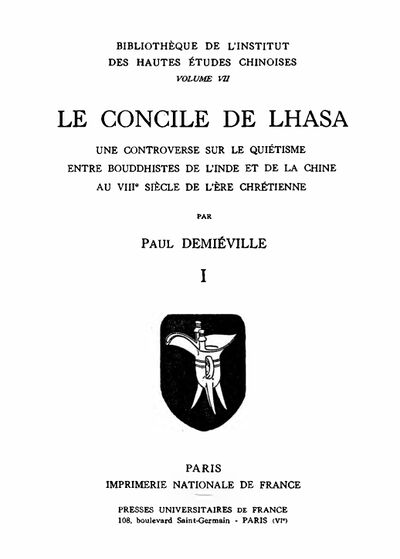|
|
| (7 intermediate revisions by the same user not shown) |
| Line 16: |
Line 16: |
|
| |
|
| *{{i|Première Partie. — TRADUCTION DU DOSSIER CHINOIS DE LA<br> CONTROVERSE|23}} | | *{{i|Première Partie. — TRADUCTION DU DOSSIER CHINOIS DE LA<br> CONTROVERSE|23}} |
| *{{i|Préface de Wang Si|23}} | | **{{i|Préface de Wang Si|23}} |
| *{{i|Première série de questions et de réponses (« anciennes » et « nouvelles », partiellement numérotées)|43}} | | **{{i|Première série de questions et de réponses (« anciennes » et « nouvelles », partiellement numérotées)|43}} |
| *{{i|Premier mémorial de Mahāyāna|110}} | | **{{i|Premier mémorial de Mahāyāna|110}} |
| *{{i|Exposé doctrinal inséré dans le mémorial|114}} | | **{{i|Exposé doctrinal inséré dans le mémorial|114}} |
| *{{i|Deuxième série de questions et de réponses (non numérotées)|120}} | | **{{i|Deuxième série de questions et de réponses (non numérotées)|120}} |
| *{{i|Deuxième mémorial de Mahāyāna|151}} | | **{{i|Deuxième mémorial de Mahāyāna|151}} |
| *{{i|Question et réponse insérées dans le mémorial|153}} | | **{{i|Question et réponse insérées dans le mémorial|153}} |
| *{{i|Troisième mémorial de Mahāyāna|157}} | | **{{i|Troisième mémorial de Mahāyāna|157}} |
|
| |
|
| | *{{i|Deuxième Partie. — COMMENTAIRE HISTORIQUE|167}} |
| | **{{i|Premier mémorial de Wang Si au Roi du Tibet|194}} |
| | **{{i|Deuxième mémorial de Wang Si au Roi du Tibet|218}} |
| | **{{i|Prières des moines chinois de Touen-houang pour le gouverneur militaire de<br> Koua-tcheou et autres personnages tibétains|239}} |
| | **{{i|Dossier de pièces émanant d’un gouverneur chinois de Touen-houang sous la<br> domination tibétaine|254}} |
| | **{{i|Éloge des mérites de Chang K'i-liu-sin-eul (Zan Khri-sum-rje)|284}} |
| | **{{i|Lettre écrite pour le préfet de Sou-tcheou, Lieou Tch’en-pi, en réponse à un<br> Tibétain du Sud, par Teou Wou|292}} |
| | **{{i|Poèmes chinois écrits sous la domination tibétaine|306}} |
|
| |
|
| Deuxième Partie. — COMMENTAIRE HISTORIQUE........................... 167
| | *{{i|Appendice. — FRAGMENTS DU DOSSIER INDIEN DE LA CONTROVERSE|333}} |
| Premier mémorial de Wang Si au Roi du Tibet............................. iq4
| | **{{i|I. Le premier ''Bhāvanā-krama'' de Kamalaśīla, analyse sommaire d’après<br> la version chinoise|333}} |
| Deuxième mémorial de Wang Si au Roi du Tibet........................... 918
| | **{{i|II. Le troisième ''Bhāvanā-krama'' de Kamalaśīla, traduction de la version<br> tibétaine par M. Étienne Lamotte|336}} |
| Prières des moines chinois de Touen-houang pour le gouverneur militaire
| | |
| de Koua-tcheou et autres personnages tibétains........................... a3g
| | *{{i|Addenda et Corrigenda|355}} |
| Dossier de pièces émanant d’un gouverneur chinois de Touen-houang
| | *{{i|Index|381}} |
| sous la domination tibétaine............... e54
| | *{{i|Table des Matières|399}} |
| Éloge des mérites de Chang K’i-liu-sin-eui (Zan Khri-sum-rje)............ a84
| | *{{i|Texte du dossier chinois de la controverse|PL. I-XXXII}} |
| Lettre écrite pour le préfet de Sou-tcheou, Lieou Tch’en-pi, en réponse
| | |StopPersonRedirects=No |
| à un Tibétain du Sud, par Teou Wou..................................... 299
| |
| Poèmes chinois écrits sous la domination tibétaine .......................... 3o6
| |
| Appendice. — FRAGMENTS DU DOSSIER INDIEN DE LA CONTROVERSE.. 333 | |
| I. Le premier Bhävanä-Icrama de Kamalas'ïla, analyse sommaire d’après | |
| la version chinoise......................................................... 333 | |
| II. Le troisième Bhâvanâ-krama de Kamalaéîla, traduction de la version | |
| tibétaine par M. Étienne Lamotte...................................... 336 | |
| Addenda et Corrigenda.................................................................. 355 | |
| Index..................................................................................................................................... 381 | |
| Table des Matières............................................................................................................ 3gg | |
| Texte du dossier chinois de la controverse . PL. I-XXXH | |
| |AddRelatedTab=No | | |AddRelatedTab=No |
| |StopPersonRedirects=No
| |
| }} | | }} |

